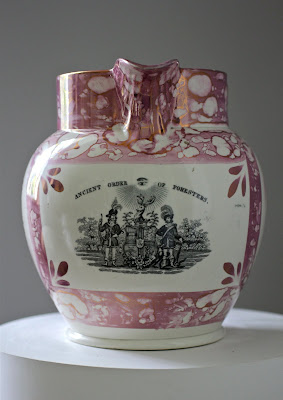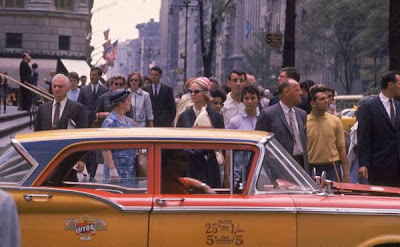The other evening Boy and I traveled out to Fort Greene, Brooklyn, where we met our friends Jasper Lambert and Francesca Montmore for dinner at a well-regarded neighborhood restaurant, known for its inventive, delicious, locavore fare. The place had a distinctly hip vibe, and the average patron was probably no older than thirty. I enjoyed it.
 |
A framed antique map of the Borough of Brooklyn
Image courtesy of Cottage Home |
Yes, even though Reggie lives on the UES of Manhattan, he is not so hidebound that he doesn't occasionally venture beyond it when he is out and about in the city. He has great respect for and enjoys visiting the storied and historic borough of Brooklyn. He actually lived in Brooklyn in the early 1980s, when he first moved to New York after college and worked in a bank on Wall Street. But that was back when people of his sort generally could only be found in one or two neighborhoods in that borough, such as Brooklyn Heights, which is where he—not surprisingly—lived at the time. Since then, Brooklyn has undergone a veritable renaissance, and today it is a thriving and vibrant metropolis full of neighborhoods that one would be delighted to live in.
But today's post is not about Brooklyn. It is about eating dessert.
Before I get to that, though, I feel I must explain why I use the word "dessert" to describe the sweet consumed at the end of a meal, instead of "pudding," as my English cousins do. Even though I sometimes prefer to use words favored in England when referring to something known by a different name in America—such as "
aubergine" for what is commonly known here as "eggplant"—I simply cannot bring myself to use the word "pudding" for "dessert," at least not with a straight face. That is because I consider "pudding" to be what I believe the English refer to as "blancmange," which is what I call the sweet, easy-to-eat, milk-based custard so favored by children in nurseries and the elderly in nursing homes. Blancmange is a type of pudding, but it is not "pudding" in the sense the English use the word, which is to describe what I call "dessert."
Now that I've got
that straightened out, I can attend to the subject at hand, which is actually
not about eating dessert, but rather about the proper utensils to use when consuming it.
Hold on, there's a logic to this meander . . .
While dining at the restaurant in Brooklyn with our friends, the four of us ordered dessert to finish our meals. I ordered what was described on the menu as rhubarb bread pudding, but which was actually a rhubarb
crisp. Not that it matters, really, but I like to be specific about these things. Anyway, the young woman who brought our desserts to the table delivered them with four teaspoons.
As she did so I asked myself, "Why is this
girl . . ." (for Reggie is now old enough to consider most women under the age of twenty five to be young enough to merit such a term) " . . . bringing me a teaspoon? I haven't ordered coffee!"
It then occurred to me that she expected me to consume my rhubarb
bread pudding crisp with a teaspoon, and not with a proper dessert spoon.
"Excuse me, miss," I said, "would you please bring me a dessert spoon?"
She looked at me quizzically.
"What do you mean?" she asked. "I just did."
"Well, actually this is a teaspoon, and not a dessert spoon. A dessert spoon is larger than this. And while you are at it, would you also please bring me a dessert fork, too?"
"But that," she said pointing to the teaspoon in front of me, "is what we eat dessert with here at the restaurant."
"That may be so," I said, "but I prefer to eat my dessert with a larger spoon. And I like to eat it with a fork, too. May I please have them so I may do so?"
She looked at me as if I were a lunatic.
"Oh, all right," she said, and shrugged.
Just as she was turning to go off and fetch what I requested, the other three people at the table piped in, in unison, "Please bring us a spoon and fork as well!"
It turns out I wasn't the only lunatic at our table.
Even though the young miss brought us each the requested spoons, the forks she provided were dinner-sized, and therefore inappropriately large for the task at hand. But rather than beginning my little routine all over again and asking her to bring me the proper sized fork, I decided to put up and shut up, and use the dinner fork. After all, I reasoned, I could still use it for the purpose I intended it for.
 |
Reggie's preferred place setting for when the first course is a soup
and the dessert course is a sweet, such as bread pudding.
That is not a teaspoon placed above the mat . . . |
Which gave me the idea for this post, which is that most people in this country haven't a
clue as to what the proper utensils are to use when consuming food at table. No, I am not referring to the use of arcane utensils favored by the Victorians at their most extreme, such as the proper fork to use for a particular type of fish, or the proper spoon to use when consuming a jellied consumé versus a creamed soup. I'm referring to the most
basic spoons and forks that one uses when eating a salad, a soup, an entrée, and dessert.
As was made clear by my Brooklyn dining experience, most people today don't understand the intended functions of a teaspoon, a dessert spoon, or a soup spoon. They don't know the difference between a dinner fork or a dessert fork, either. And it is not only in the wilds of Brooklyn that one encounters such ignorance. I've even witnessed it in my own house, when dining at my own table. You would be surprised at how many of our dinner party guests use the wrong utensils with which we have set our table at Darlington House. And these guests of ours are not bumpkins—they are educated, worldly, and cultured people, accustomed to attending dinner parties and dining in smart restaurants.
So here's the deal. A teaspoon's primary purpose is to stir a cup of tea or coffee. It is
not designed to be used to consume food, at least by adults, even though it does an admirable job of delivering modest amounts of food to one's mouth. A dessert spoon, also known as a tablespoon, is larger than a teaspoon and delivers a more generous (and more pleasing) amount of food—a mouthful—than a teaspoon is capable of administering. A tablespoon is the primary and most versatile spoon that one uses when consuming food at table.
 |
Eeny, meeny, miny, moe
teaspoon, tablespoon, soup spoon, go! |
Although some people use tablespoons to consume soup, and Reggie believes it is acceptable to do so in certain cases (particularly in households where the silverware services are not as extensive as his own), he prefers to consume soup using the larger spoons designed for such purpose, and not a tablespoon. And it is not simply because he is able to do so, having the necessary spoons at his disposal. No, it is because he
adores soup and he finds using the larger spoon allows him to consume more of it with each mouthful than would be possible with a tablespoon, and certainly far more than would be possible with an unsatisfyingly small teaspoon.
When we set the table at Darlington House for a meal where dessert is provided, we almost always set it with a dessert-sized fork and a dessert spoon to consume the sweet. The fork is smaller than the one provided to consume the main course of the meal, and the spoon is a tablespoon. Both are placed above the plate, so their intended use is absolutely clear. When it comes time to eat the dessert, one holds the fork in one's left hand and the spoon in one's right, and uses them together, as opposed to endlessly exchanging one for the other in one's primary hand (the way many Americans use a knife and fork when cutting into and consuming a piece of meat).
 |
A rather elaborate, and to Reggie rather over-set,
formal place setting diagram
Image courtesy of simplehuman |
If you have not eaten dessert using a spoon and fork as I describe here, I encourage you to take it upon yourself to do so. You will be pleased with how pleasant it is, and how much more you appreciate the pleasure of taking your dessert, as opposed to eating it with just a teaspoon. Once you become accustomed to consuming your dessert this way, with a spoon and fork, you will marvel at how you ever did it any other way (that is, except when eating fruit or cheese at the end of a meal, which is when you would instead use a fork and
knife).
 |
Reggie's preferred place setting for when the first course is a salad
and the dessert course is either fruit or cheese |
Oh, and the rhubarb
bread pudding crisp that triggered this story? It was delicious, but it would have benefitted from having a small
pitcher jug of
crème anglaise available to pour over it, to moisten it. Now that is one English custom—the pouring of creams and custards over one's
pudding dessert—that I have unashamedly adopted as my own. And I suggest that you do, too.
But,
please eat your dessert with the proper spoon and fork!
Tell me, do you?
Photographs, unless noted, by Boy Fenwick


















































































































